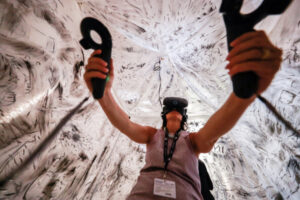A team of researchers has come up with a way to use virtual reality to build awareness about climate change and sea-level rise.
The team comprises researchers from the Middlebury Institute of International Studies at Monterey, Stanford’s Virtual Human Interaction Lab, the Lemann Center at Stanford, the Nature Conservancy, the city of Santa Cruz, and Virtual Planet Technologies. They came together to evaluate the effectiveness of virtual reality as a tool for engaging the communities and disseminating knowledge about the negative implications of sea-level rise. Their research was published on May 13 in the peer-reviewed journal Water.
“This is the first time that people can actually see and experience what the future of their communities could look like in a way that can help inform a conversation about the future,” said Juliano Calil, a senior research fellow at Middlebury Institute of International Studies Center for the Blue Economy and lead researcher on the project.
Calil began his career as an IT consultant but soon drifted towards a more fulfilling career path that would benefit the planet. While flying drones to study how king tides affect Santa Cruz during his Ph.D. in ocean sciences, he figured out the usability of high-quality visuals from the drone to spread awareness about sea-level rise.
“Through the Ph.D. program, I found the need for a different way to communicate some of the complex issues related to climate change,” he said.
He founded Virtual Planet Technologies, a climate communication startup based in Santa Cruz, in no time. The company develops immersive and innovative ways to inspire communities about bringing up conversations on issues revolving around climate change.
For the said research project, Calil teamed up with Tiffany Wise-West, the program manager for the Resilient Coast Santa Cruz initiative. The initiative had deployed virtual reality for the purpose previously, proving to be a highly effective tool.
“It’s an immersive and tangible way to make concepts like climate change real for people,” Wise-West says.
Over the course of the research, the team organized more than 50 events that led to some 1,500 conversations with city residents and stakeholders. In addition, they took the participants to a hyper-realistic future Santa Cruz through virtual reality headsets to demonstrate the outcome of sea-level rise over a considerable amount of time.
“There was a huge difference between how people were talking about [sea level rise] and how engaged they were after seeing things in virtual reality,” said Calil.
Follow us on LinkedIn
Read other Articles





